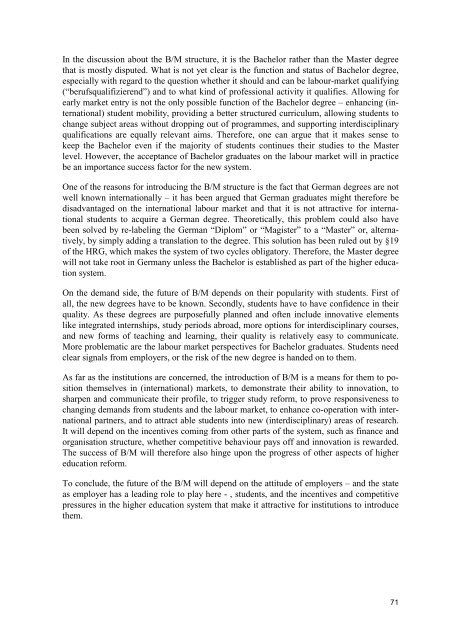and Master Programmes in German Higher Education Institutions
and Master Programmes in German Higher Education Institutions
and Master Programmes in German Higher Education Institutions
- No tags were found...
Create successful ePaper yourself
Turn your PDF publications into a flip-book with our unique Google optimized e-Paper software.
In the discussion about the B/M structure, it is the Bachelor rather than the <strong>Master</strong> degreethat is mostly disputed. What is not yet clear is the function <strong>and</strong> status of Bachelor degree,especially with regard to the question whether it should <strong>and</strong> can be labour-market qualify<strong>in</strong>g(“berufsqualifizierend”) <strong>and</strong> to what k<strong>in</strong>d of professional activity it qualifies. Allow<strong>in</strong>g forearly market entry is not the only possible function of the Bachelor degree – enhanc<strong>in</strong>g (<strong>in</strong>ternational)student mobility, provid<strong>in</strong>g a better structured curriculum, allow<strong>in</strong>g students tochange subject areas without dropp<strong>in</strong>g out of programmes, <strong>and</strong> support<strong>in</strong>g <strong>in</strong>terdiscipl<strong>in</strong>aryqualifications are equally relevant aims. Therefore, one can argue that it makes sense tokeep the Bachelor even if the majority of students cont<strong>in</strong>ues their studies to the <strong>Master</strong>level. However, the acceptance of Bachelor graduates on the labour market will <strong>in</strong> practicebe an importance success factor for the new system.One of the reasons for <strong>in</strong>troduc<strong>in</strong>g the B/M structure is the fact that <strong>German</strong> degrees are notwell known <strong>in</strong>ternationally – it has been argued that <strong>German</strong> graduates might therefore bedisadvantaged on the <strong>in</strong>ternational labour market <strong>and</strong> that it is not attractive for <strong>in</strong>ternationalstudents to acquire a <strong>German</strong> degree. Theoretically, this problem could also havebeen solved by re-label<strong>in</strong>g the <strong>German</strong> “Diplom” or “Magister” to a “<strong>Master</strong>” or, alternatively,by simply add<strong>in</strong>g a translation to the degree. This solution has been ruled out by §19of the HRG, which makes the system of two cycles obligatory. Therefore, the <strong>Master</strong> degreewill not take root <strong>in</strong> <strong>German</strong>y unless the Bachelor is established as part of the higher educationsystem.On the dem<strong>and</strong> side, the future of B/M depends on their popularity with students. First ofall, the new degrees have to be known. Secondly, students have to have confidence <strong>in</strong> theirquality. As these degrees are purposefully planned <strong>and</strong> often <strong>in</strong>clude <strong>in</strong>novative elementslike <strong>in</strong>tegrated <strong>in</strong>ternships, study periods abroad, more options for <strong>in</strong>terdiscipl<strong>in</strong>ary courses,<strong>and</strong> new forms of teach<strong>in</strong>g <strong>and</strong> learn<strong>in</strong>g, their quality is relatively easy to communicate.More problematic are the labour market perspectives for Bachelor graduates. Students needclear signals from employers, or the risk of the new degree is h<strong>and</strong>ed on to them.As far as the <strong>in</strong>stitutions are concerned, the <strong>in</strong>troduction of B/M is a means for them to positionthemselves <strong>in</strong> (<strong>in</strong>ternational) markets, to demonstrate their ability to <strong>in</strong>novation, tosharpen <strong>and</strong> communicate their profile, to trigger study reform, to prove responsiveness tochang<strong>in</strong>g dem<strong>and</strong>s from students <strong>and</strong> the labour market, to enhance co-operation with <strong>in</strong>ternationalpartners, <strong>and</strong> to attract able students <strong>in</strong>to new (<strong>in</strong>terdiscipl<strong>in</strong>ary) areas of research.It will depend on the <strong>in</strong>centives com<strong>in</strong>g from other parts of the system, such as f<strong>in</strong>ance <strong>and</strong>organisation structure, whether competitive behaviour pays off <strong>and</strong> <strong>in</strong>novation is rewarded.The success of B/M will therefore also h<strong>in</strong>ge upon the progress of other aspects of highereducation reform.To conclude, the future of the B/M will depend on the attitude of employers – <strong>and</strong> the stateas employer has a lead<strong>in</strong>g role to play here - , students, <strong>and</strong> the <strong>in</strong>centives <strong>and</strong> competitivepressures <strong>in</strong> the higher education system that make it attractive for <strong>in</strong>stitutions to <strong>in</strong>troducethem.71
















